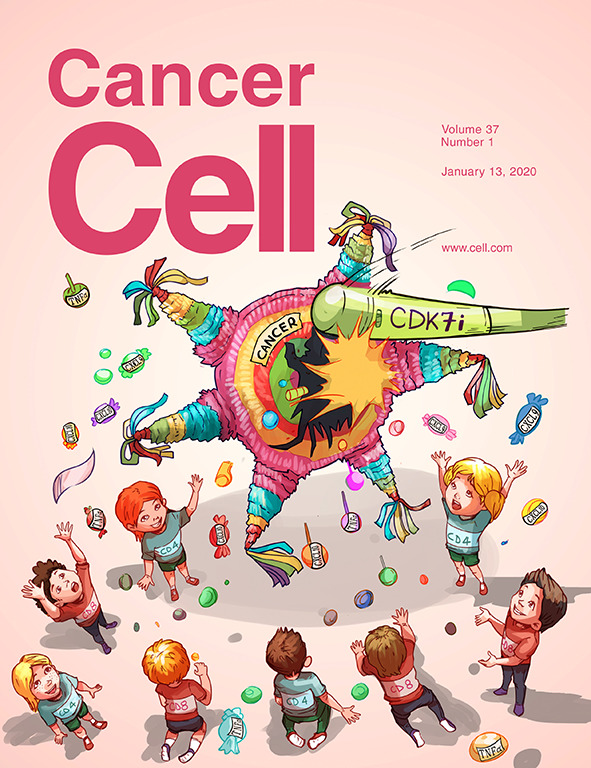SHR-A1811抗体-药物偶联物在her2阳性乳腺癌新辅助治疗中疗效的空间决定因素
IF 48.8
1区 医学
Q1 CELL BIOLOGY
引用次数: 0
摘要
选择下一代抗人表皮生长因子受体2 (HER2)抗体-药物偶联物(adc)的最佳候选物仍然具有挑战性。我们使用DNA和RNA测序、计算病理学和单细胞原位空间成像技术,开展了一项预先指定的翻译研究,以确定接受shra1811治疗的her2阳性乳腺癌患者的治疗生物标志物。在激素受体(HR)阴性亚组中,更高比例和更多的免疫细胞(即肿瘤浸润淋巴细胞[TILs])浸润,特别是细胞毒性T细胞,与更好的治疗反应相关。在HR阳性亚组中,HER2强阳性肿瘤细胞的紧密性和聚集性,而不是均匀分布,与较低的反应率和HER2发光样(HER2- lum)亚型(更接近于HR+/HER2 -乳腺癌)有关。此外,我们开发了一种临床实用的预测模型,能够根据临床病理特征和病理图像预测SHR-A1811和其他新型adc的新辅助治疗反应。本文章由计算机程序翻译,如有差异,请以英文原文为准。

Spatial determinants of antibody-drug conjugate SHR-A1811 efficacy in neoadjuvant treatment for HER2-positive breast cancer
Selecting optimal candidates for next-generation anti-human epidermal growth factor receptor 2 (HER2) antibody-drug conjugates (ADCs) remains challenging. We conduct a prespecified translational study to identify treatment biomarkers in SHR-A1811-treated HER2-positive breast cancer patients from the phase 2 neoadjuvant FASCINATE-N trial using DNA and RNA sequencing, computational pathology, and single-cell in situ spatial imaging. In the hormone receptor (HR)-negative subgroup, a higher proportion and more infiltration of immune cells (i.e., tumor-infiltrating lymphocytes [TILs]), particularly cytotoxic T cells, are associated with better treatment responses. In the HR-positive subgroup, the closeness and aggregation of HER2-strong-positive tumor cells, as opposed to a uniform distribution, are linked to a lower response rate and HER2 luminal-like (HER2-LUM) subtype, which more closely resembles HR+/HER2− breast cancer. In addition, we develop a clinically practical predictive model capable of predicting neoadjuvant treatment responses to SHR-A1811 and other novel ADCs based on clinicopathological characteristics and pathological images.
求助全文
通过发布文献求助,成功后即可免费获取论文全文。
去求助
来源期刊

Cancer Cell
医学-肿瘤学
CiteScore
55.20
自引率
1.20%
发文量
179
审稿时长
4-8 weeks
期刊介绍:
Cancer Cell is a journal that focuses on promoting major advances in cancer research and oncology. The primary criteria for considering manuscripts are as follows:
Major advances: Manuscripts should provide significant advancements in answering important questions related to naturally occurring cancers.
Translational research: The journal welcomes translational research, which involves the application of basic scientific findings to human health and clinical practice.
Clinical investigations: Cancer Cell is interested in publishing clinical investigations that contribute to establishing new paradigms in the treatment, diagnosis, or prevention of cancers.
Insights into cancer biology: The journal values clinical investigations that provide important insights into cancer biology beyond what has been revealed by preclinical studies.
Mechanism-based proof-of-principle studies: Cancer Cell encourages the publication of mechanism-based proof-of-principle clinical studies, which demonstrate the feasibility of a specific therapeutic approach or diagnostic test.
 求助内容:
求助内容: 应助结果提醒方式:
应助结果提醒方式:


